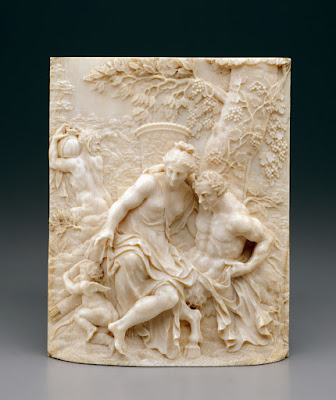-Galleria-Borghese-Rome.jpg) |
| Ancient Roman Culture Asclepius 2nd century AD marble (assembled from non-matching ancient fragments and newly-carved 17th-century extensions) Galleria Borghese, Rome |
-British-Museum.png) |
| Ancient Greek Culture Torso of Asklepios 4th century BC marble (included among the Elgin Marbles) British Museum |
 |
| Ancient Roman Culture Pan with Eagle and Ram 2nd century AD marble Galleria Borghese, Rome |
 |
| Ancient Greek Culture Herm of Pan AD 10 marble Galleria Borghese, Rome |
 |
| Auguste Rodin Bust of Athena 1905 marble Musée des Beaux-Arts de Lyon |
 |
| Ancient Roman Culture Athena 2nd century AD marble Gemäldegalerie, Dresden |
 |
| Ancient Roman Culture Athena AD 150 marble Gemäldegalerie, Dresden |
 |
| Anonymous Emilian Artist Centerpiece with Mercury surrounded by other Deities 19th century glazed earthenware Museo Civico di Modena |
 |
| Ancient Roman Culture Altar with Mercury and Athena 1st century BC - 1st century AD marble Cleveland Museum of Art, Ohio |
 |
| Ancient Roman Culture Torso of Mercury early 1st century AD marble Museum of Fine Arts, Boston |
 |
| Ancient Roman Culture Torso of Mercury 2nd century AD marble Fine Arts Museums of San Francisco (Palace of the Legion of Honor) |
 |
| Adolf von Hildebrand Mercury at Rest 1886 plaster Neue Pinakothek, Munich |
-c1575-A-terracotta-modello-Rhode-Island-School-of-Design-Providence.jpg) |
| Giambologna River God (Euphrates) ca. 1575 terracotta modello Rhode Island School of Design, Providence |
-c1575-B-terracotta-modello-Rhode-Island-School-of-Design-Providence.jpg) |
| Giambologna- River God (Euphrates) ca. 1575 terracotta modello Rhode Island School of Design, Providence |
 |
| Ignaz Elhafen Jupiter and Antiope ca. 1690 ivory relief Detroit Institute of Arts |
 |
| Baccio Bandinelli Jupiter ca. 1547-48 marble Giardino di Boboli, Florence |
The Curse of Cromwell
You ask what I have found and far and wide I go,
Nothing but Cromwell's house and Cromwell's murderous crew,
The lovers and the dancers are beaten into the clay,
And the tall men and the swordsmen and the horsemen where are they?
And there is an old beggar wandering in his pride
His fathers served their fathers, before Christ was crucified.
The lovers and the dancers are beaten into the clay,
And the tall men and the swordsmen and the horsemen where are they?
And there is an old beggar wandering in his pride
His fathers served their fathers, before Christ was crucified.
O what of that, O what of that
What is there left to say?
All neighbourly content and easy talk are gone,
But there's no good complaining, for money's rant is on,
He that's mounting up must on his neighbour mount
And we and all the Muses are things of no account.
They have schooling of their own but I pass their schooling by,
What can they know that we know that know the time to die?
O what of that, O what of that
What is there left to say?
But there's another knowledge that my heart destroys
As the fox in the old fable destroyed the Spartan boy's
Because it proves that things both can and cannot be;
As the fox in the old fable destroyed the Spartan boy's
Because it proves that things both can and cannot be;
That the swordsmen and the ladies can still keep company;
Can pay the poet for a verse and hear the fiddle sound,
That I am still their servant though all are underground.
Can pay the poet for a verse and hear the fiddle sound,
That I am still their servant though all are underground.
O what of that, O what of that
What is there left to say?
What is there left to say?
I came on a great house in the middle of the night
Its open lighted doorway and its windows all alight,
And all my friends were there and made me welcome too;
But I woke in an old ruin that the winds howled through;
Its open lighted doorway and its windows all alight,
And all my friends were there and made me welcome too;
But I woke in an old ruin that the winds howled through;
And when I pay attention I must out and walk
Among the dogs and horses that understand my talk.
Among the dogs and horses that understand my talk.
O what of that, O what of that
What is there left to say?
– W.B. Yeats (1938)